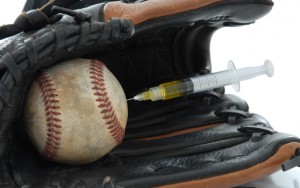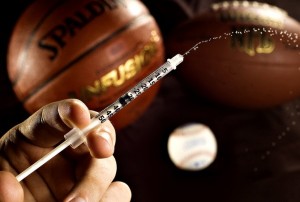In a society that obsesses over competitive sports, it is only natural that athletes would look to gain an extra edge on their competition. Steroid use is not a new concept – going as far back as seven-time Mr. Olympia winner, Arnold Schwarzenegger, who admitted to using steroids during his run as a professional bodybuilder.
When the media breaks a story of a well-known athlete setting season records for touchdowns or home runs, it is often discussed that there might be a suspicion that they may be using some sort of performance-enhancing drugs, like steroids.
An investigation by the “U.S. News and World Report” found that four in 10 teenage steroid users were influenced by the notion that famous athletes were using them as well. That same survey discovered that 57 percent of teen steroid users were prompted to use them after reading muscle magazines.
As you can see, this can create a trickle-down effect, and give the impression to younger athletes (high school and college) that taking illegal supplements can have rewarding effects on their athletic performance, without considering the possible side effects it can have on their bodies, as they get older.
Despite the attention of steroid abuse among professional athletes, medical experts are growing more concerned about the drugs’ impact on younger users.
Let’s find out why.
The Use of Anabolic Steroids
Anabolic steroids are synthetic variations related to male sex hormones. Doctors use anabolic steroids to help treat some hormone problems in men, like delayed puberty, and muscle loss from certain diseases, like AIDS.
According to MedlinePlus.gov, bodybuilders and athletes often use anabolic steroids to increase muscle mass, definition and overall athletic performance. However, using them in this capacity is not only illegal, but has been linked to a plethora of health problems, such as:
• Acne
• Breast growth (aka “bitch tits”) and shrinking of testicles in men
• Voice deepening and growth of facial hair in women
• High blood pressure
• Heart problems, including heart attack
• Liver disease, including cancer
• Kidney damage
• Aggressive behavior (aka “roid rage”)
Although designated as a controlled substance in 1990 by the U.S. government, athletes and bodybuilders continue to use them illegally to increase mass and strength. Because the effectiveness of steroids greatly decreases during continuous use, experienced athletes will inject or pop the drugs for eight to 12 weeks in patterns, known as “cycling” – allowing their bodies to rest for several months before beginning another round, according to an article on Nbcnews.com titled, “Steroid Addiction a Risk for Young Athletes.”
 New research has suggests that the drugs can cause a powerful psychological dependency, and stopping them often requires careful medical oversight. Withdrawal can sometimes cause severe depression among the user, which can last for months.
New research has suggests that the drugs can cause a powerful psychological dependency, and stopping them often requires careful medical oversight. Withdrawal can sometimes cause severe depression among the user, which can last for months.
“What we worry about most is people getting so depressed that they become suicidal,” says Dr. Kirk Brower, head of the University of Michigan’s Chelsea Arbor Addiction Treatment Center in Detroit. “Adolescents are more vulnerable to [steroid withdrawal] because they’re already at a high risk for suicide.”
In a 1991 study at the University of Michigan, 84 percent of participants reported some kind of withdrawal effects from steroids, adds Brower.
“Common reaction was depressed mood, fatigue, trouble sleeping, decreased sex drive and the desire to take more steroids,” says Brower.
A Star is Born
With the enticing promise of becoming more sexually attractive amongst their peers, becoming popular and increasing their chances to become the star of the football team, what high school athlete could resist the temptation to experiment with anabolic steroids?
If your son plays football, he could be among the 13 percent of teens believed to be using steroids. So, if your daughter plays a sport like basketball, then she should be safe, right?
Think again.
According to an article in The Huffington Post titled, “Are Student Athletes Taking Steroids,” the rate of steroid use among females playing high school basketball is 8.8 percent. If you think these numbers are small, consider that 40 to 50 percent of high school and college athletes are taking some sort of supplement with their workouts.
“I’ll just do one cycle and quit. I won’t get addicted.”
These are just a few common remarks that are made by individuals contemplating using steroids – or another form of performance-enhancing drug – for the first time.
According to medical experts, steroid use among high school athletes is at an all-time high, and many officials fear that the temptation to use could continue to spiral out of control, with athletes’ drive to become bigger, faster and stronger.
The Centers for Disease Control and Prevention (CDC) says that up to 11 percent of all high school males reported trying steroids, and six percent have taken them for an entire eight to 12 week cycle.
A 2002 National Institute on Drug Abuse study discovered that 2.5 percent of 8th graders, 2.5 percent of 10th graders and four percent of 12th graders admitted to using steroids at one point.
According to an article on Sfgate.com titled, “More High School Athletes Risking Steroid Use,” teenagers dramatically increase their risk beyond possible organ damage and other documented side effects (including infertility, hair loss and severe acne). Steroids can also stunt the growth plates in high school students, which means a teen that would otherwise grow to be six feet tall, might only grow to be 5-foot-6.
Some doctors recommend that high school athletes refrain from using creatine, a popular, legal supplement used by many professional athletes to help speed up recovery time and enhance strength and athletic performance. However, no studies have firmly established the long-term effects of creatine use.
Teenagers often view themselves as being immune to the health hazards linked to the use of performance-enhancing drugs. Rick Steen, baseball coach at San Ramon Valley High in Danville, Calif., hears some players defend creatine and other supplements by saying that there is no concrete evidence of ill effects.
“I tell them in 15 years, when their ear winds up in the middle of their face, don’t come crying to me,” Steen said.
Most competitive athletes who are experienced with steroid use know not to go cold turkey. However, student athletes who are worried about being tested – or getting caught by their parents – don’t realize the adverse effects that sudden withdrawal can have on the body.
“Steroids are a controlled prescription drug, like a hardcore pain medication,” says Dr. Jon Divine, director of the Sports Medicine at Cincinnati Children’s Hospital Medical Center. “It really takes close monitoring to get off the drug.”
 Testing Student Athletes For Steroids
Testing Student Athletes For Steroids
Even with the increase in steroid use among high school students, most school districts are not testing their athletes for illegal performance-enhancing drugs. However, in 2014, Florida’s Miami-Dade County Public Schools – one of the largest school districts in the U.S. – made a bold move, as they began a pilot program for testing their student athletes for steroids.
“We are very concerned about the use of these illegal drugs,” says Marcos Moran, assistant superintendent of school operations in the district.
Moran stated that the district anticipated testing approximately 250-300 student athletes at the high school level through the program.
About 20 percent of high schools in the U.S. have student drug testing policies, according to a study from the University of Pennsylvania.
“There are school districts that do conduct limited drug testing, but in terms of nationally, it’s not very common,” says Annie Skinner, spokeswoman for U.S. Anti-Doping Agency, which manages drug testing for the U.S. Olympic teams.
A typical drug panel tests for marijuana, amphetamines, opioids, cocaine and PCP, according to the National Institute on Drug Abuse.
“I think it is a challenge, certainly to fight the external pressures that students face, and we know that,” says Skinner. “There’s the pressure to make the football team. There’s the pressure to do the best you can in high school to get that college scholarship, and so the pressures on young athletes are very intense.”
Solving The Problem
In order to decrease steroid use among high school athletes, parents and coaches must take action and talk with their student athletes early on about the effects – both negative and positive – of steroids. By teaching kids about both the positive and negative effects of the drugs, gives them a more balanced approach to the topic, rather than just focusing on the negative effects.
Oregon Health & Science University has developed two programs that effectively address steroids in high school sports – ATLAS (Athletes Training & Learning to Avoid Steroids) and ATHENA (Athletes Targeting Healthy Exercise & Nutrition Alternatives). Both of these programs are peer-led, gender-specific and help athletes learn about healthy sports nutrition and training.
“What’s important is to teach kids how to eat correctly,” says Dr. Linn Goldberg, from Oregon Health & Science University of Portland, and co-developer of the ATLAS and ATHENA programs.
“Teaching kids how to obtain protein through food, the importance of eating breakfast and avoiding muscle toxins – like alcohol and marijuana – can help young athletes become stronger without the use of shakes, supplements – and most importantly – the use of steroids,” Goldberg said.



